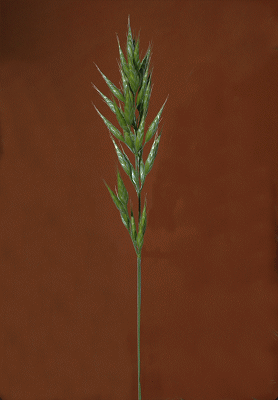Bromus racemosus* Linn. Sp. Pl.ed. 2: 114 (1762).
Classification. (GPWG 2001) : Subfamily Pooideae. Tribe Bromeae.
Type of Basionym or Protologue Information: LT: Anon., (LINN-93.31). LT designated by P. M. Smith, Notes Roy. Bot. Gard. 42: 499 (1985).
Key references (books and floras): [2002] D.Sharp & B.K.Simon, AusGrass, Grasses of Australia, [2008] S.W.L.Jacobs, R.D.B.Walley & D.J.B.Wheeler, Grasses of New South Wales (176), [2009] A.Wilson (ed.). Flora of Australia, Vol 44A. Poaceae 2 (83).
Illustrations: [2008] S.W.L.Jacobs, R.D.B.Whalley & D.J.B.Wheeler, Grasses of New South Wales, 4th edn (176).
Habit. Annual. Culms erect or geniculately ascending, 10–150 cm tall, 2–7(–9) -noded. Leaf-sheaths hairy. Ligule an eciliate membrane, 1–3 mm long, erose. Leaf-blades 5–20 cm long, 2–5(–8) mm wide. Leaf-blade surface indumented.
Inflorescence. Inflorescence compound, a panicle. Panicle elliptic or oblong, dense, 4–33.5 cm long, 1.5–4 cm wide.
Spikelets. Spikelets pedicelled. Fertile spikelets many flowered, with at least 2 fertile florets (4–9), comprising 4–9 fertile floret(s), with diminished florets at the apex, oblong or ovate, laterally compressed, 10.5–20 mm long.
Glumes. Glumes similar, thinner than fertile lemma. Lower glume oblong, chartaceous, without keels, 3–5 -nerved. Upper glume elliptic, 4.5–8 mm long, chartaceous, without keels or keeled, 5–9 -nerved.
Florets. Fertile lemma 6.5–8.3 mm long, without keel, 7–9 -nerved. Lemma surface glabrous. Lemma apex dentate, awned, 1 -awned. Median (principal) awn subapical, 3.5–10 mm long overall. Lodicules present. Anthers 3.
Continental Distribution: Europe, Africa, Temperate Asia, Australasia, North America, and South America.
Australian Distribution: New South Wales, Victoria.
New South Wales: South Coast, Northern Tablelands. Victoria: Gippsland Plain, East Gippsland.
Notes. Introduced. N.S.W. with a single collection seen from S.A. and two from Vic. Native of much of Europe. In disturbed, often swampy ground. Flowers Nov.-Dec. Fruits Dec.-Jan.



